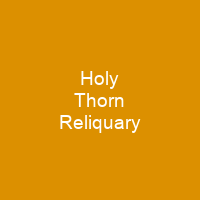The Holy Thorn Reliquary: A Golden Gem from the Middle Ages
Imagine a treasure so precious that it has survived centuries of history, wars, and restorations. The Holy Thorn Reliquary, created in the 1390s for John, Duke of Berry, is one such gem. This magnificent piece of artistry not only houses a relic from the Crown of Thorns but also serves as a window into the intricate world of medieval craftsmanship.
The Artistry and Technique
Imagine the Holy Thorn Reliquary as a masterpiece crafted by an unseen artist, using techniques that were cutting-edge for their time. Made primarily of gold with jewels and pearls, this reliquary features 28 three-dimensional figures in white enamel, created through the technique known as enamelling en ronde bosse. Each figure is a testament to the skill and dedication of its creator.
The Front and Rear Faces
Now, picture the front face of this reliquary. It depicts a grand scene of the end of the world and the Last Judgement, with God the Father, angels, Christ, John the Baptist, Mary, and the 12 Apostles. The rear view, however, is less extravagant, featuring plain gold in low relief. This contrast between the two faces adds depth to its narrative and artistic value.
A Rich History
Where has this precious relic been? For centuries, it was part of the Habsburg collections until a forgery replaced it during restoration. In 1898, Ferdinand de Rothschild bequeathed the original reliquary to the British Museum as part of the Waddesdon Bequest.
The Reliquary’s Journey
From its creation in the 1390s until it reached the British Museum, the Holy Thorn Reliquary has had a fascinating journey. It was owned by various notable figures and passed through different collections before being restored by Salomon Weininger. The Viennese Rothschild family acquired it by 1872, inheriting it from Ferdinand de Rothschild who moved to England.
Details and Significance
The reliquary stands at 30 centimeters high and weighs 1.4 kilograms. Its central compartment contains the relic protected by rock crystal, with white enamel dominating the design and gold used for hair. The front face features a scroll label inscribed about the thorn from the Crown of Thorns.
Each side of the reliquary has its own story. One door depicts Saint Michael spearing a dragon representing the devil, while the other shows Saint Christopher carrying the Christ child on his shoulders. These figures are executed in an International Gothic style and were possibly originally enamelled but now feature opaque enamel.
The Unknown Maker
Despite its intricate design, the maker of the reliquary remains unknown. Goldsmiths of the period rarely signed their work, making it challenging to attribute this masterpiece definitively. However, the use of ronde bosse technique and the controlled use of color indicate a high level of skill.
A Reliquary’s Purpose
Why was such an elaborate reliquary created? Jean, duc de Berry commissioned similar works, including scenes from courtly life. The Holy Thorn Reliquary may have been given away or kept in a chapel, serving as a powerful symbol of faith and devotion.
The Crown of Thorns
According to records, the crown containing the Holy Thorn was bought by Louis IX from Baldwin II in Constantinople. Berry might have kept it with him on his travels or stored it in a chapel. This relic’s significance cannot be overstated; it connects us to one of history’s most revered moments.
Conclusion
The Holy Thorn Reliquary is more than just an artifact—it is a bridge between the past and present, connecting us to the rich tapestry of medieval artistry and faith. Its survival through centuries speaks volumes about its importance and the dedication of those who preserved it.

You want to know more about Holy Thorn Reliquary?
This page is based on the article Holy Thorn Reliquary published in Wikipedia (retrieved on November 29, 2024) and was automatically summarized using artificial intelligence.







